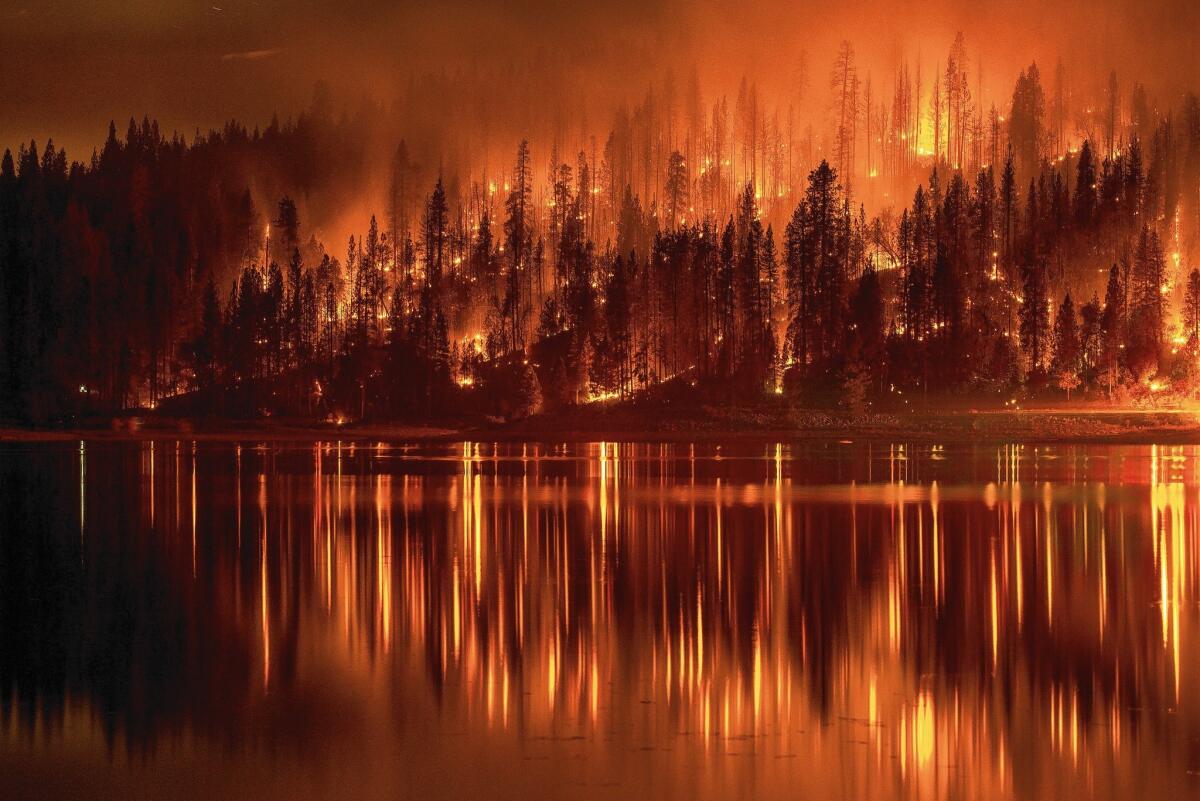Climate change may add billions to wildfire costs, study says

- Share via
Reporting from TUCSON — As wildfires burned in California, a study by several major environmental groups estimated that climate change could mean that future blazes will be much larger and add billions of dollars to already costly losses.
The 46-page study released Tuesday, titled “Flammable Planet: Wildfires and the Social Cost of Carbon,” is part of an ongoing project by three groups to examine what it calls the missing risks, such as wildfires, that climate change can make more expensive. The groups are the Environmental Defense Fund, the Institute for Policy Integrity at NYU School of Law, and the Natural Resources Defense Council.
U.S. wildfires cost as much as $125 billion annually, but climate change could add as much as $60 billion to the bill by 2050, the study said. The projected cost increase is attributed to an expanding area in which wildfires burn — estimated to be 50% to 100% larger by 2050. California “could experience a 36% to 74% increase in area burned by 2085 under a high emissions path,” the study said.
“Climate change is here now, and its toll on our health and economy is rising every day,” said Laurie Johnson, chief economist at NRDC.
“The current scientific consensus is that wildfire risk will increase in many regions of the world as climate change leads to warmer temperatures, more frequent droughts, and changing precipitation patterns,” the study said. “Fires are expected to become more frequent and intense, and fire seasons are projected to last longer.”
However, fire officials in several Western states said climate change wasn’t solely to blame for the size and cost of fires. Other factors must be considered, they said, such as hundreds of years of overly aggressive fire suppression, leading to overcrowded forests that will continue to spark more intense wildfires.
“That problem only grew as we went from periods of abundant rainfall, to average rainfall and then to drought,” said Dan Ware, fire prevention and outreach program manager for New Mexico State Forestry.
Jim Paxon, who retired from the U.S. Forest Service in New Mexico in 2003, serving as a spokesman for major wild-land fires for 13 years, blamed lack of forest management — not just climate change — for an explosion of unwieldy and costly wildfires in the West.
Lack of prescribed burns and less timber cutting are major factors, said Paxon, who now serves as special assistant to the Arizona Game and Fish Department.
“I could spend hours showing some daylight on what it has cost us taxpayers since the demise of the timber industry at the hands of enviro-litigants,” he said. “Now we have mega-fires as a partial consequence.”
According to federal statistics released Tuesday, firefighters were battling 15 uncontained large fires, eight of which were in California. Between 7 million to 9 million acres are burned each year in the United States, while globally the damage is 865 million acres.
How to measure the full cost of a wildfire is complicated and becomes difficult depending on what is included in calculations. The cost includes direct market damages such as lost timber and property, non-market damages such as health effects, and added expenditures such as fire prevention, the study said.
“Research suggests that the total costs of a wildfire are typically 10 to 50 times its suppression costs,” the study said. “Given that the United States spends roughly $2.0 [billion] to $2.5 billion on wildfire suppression per year, we estimate that the total cost of U.S. wildfires is presently between $20 billion and $125 billion annually.”
Although most fire officials agree that the cost of fighting fires will probably keep increasing, there isn’t consensus on the costs anticipated by 2050.
“The projection given in the report is concerning, but with millions of dollars dedicated to hazardous fuels mitigation, forest and watershed thinning treatments and prevention outreach, our hope is that will also mitigate costs spent on fire suppression,” Ware said.
Paxon said the cost of fighting wildfires had increased dramatically since he started his career in 1969. It used to cost hundreds of dollars an acre to suppress wildfires when he first joined the agency. By 2000, it was in the tens of thousands, he said, because inappropriate forest management had led to enormous fires.
He described the new report as “pretty extreme,” saying that although fires change the vegetation and — in the hottest blazes — soil and watersheds may take decades to recover, millions of acres of forests are not “destroyed,” as stated in the study.
Kent Hamilton, Rocky Mountain aviation safety manager for the U.S. Forest Service, said the complexities of fighting fires in modern times contributed to escalating costs. For instance, modern aircraft fleets for fire suppression are more expensive but more effective than in years past, increasing the margin of safety for the firefighters on the ground, he said.
More to Read
Sign up for Essential California
The most important California stories and recommendations in your inbox every morning.
You may occasionally receive promotional content from the Los Angeles Times.















